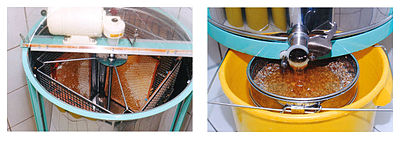Honey extractor
A honey extractor is a machine ( beekeeping device ) that uses centrifugal force to extract honey from honeycombs . When extracting honey, centrifuging is the beekeeper's essential work step . Another job that is directly related to spinning is the uncapping of the honeycomb. In addition, the honey coming out of the centrifuge runs through a sieve that mainly holds back wax particles.
Structure and functionality
The honey extractor consists of a cylindrical drum, a honeycomb basket, which is firmly connected to a rotary shaft and a drive, and a discharge tap.
For spinning, depending on the version, several (2 to 52 and even more) uncapped honeycombs are inserted into the honeycomb basket and the basket is then rotated using the drive. As a result of the centrifugal force , the honey squirts out of the honeycomb onto the inner wall of the drum, runs down it, and finally flows from the tap over the honey sieve into a collecting container (bucket).
Executions
There are honey extractors with electric and manual drives (rotary crank with free-wheel drive). Depending on the type of honey extractor, the uncapped honeycombs must be turned manually by the beekeeper (tangential extractor) or the turning process is carried out using a control on the honey extractor itself (self-turning extractor).
There are a total of three types of honey extractors: Tangential extractors - there the honeycombs are inserted tangentially into the boiler, ie one side of the honeycomb points towards the boiler wall (this is then emptied during the centrifugal process), the direction of rotation does not matter. Radial centrifuge - there the honeycombs are quasi "star-shaped" in the boiler and both sides are emptied at the same time during the centrifuging process (this can lead to honeycomb breakage if the honey is too viscous and does not withstand the centrifugal forces or is thrown too abruptly or . is braked too abruptly). The direction of rotation is irrelevant here. The self-turning extractor consists of a honeycomb basket in which there are individually suspended or movable honeycomb pockets - the great advantage is that the honeycombs can be centrifuged tangentially and with the best possible support from the honeycombs and the turning process does not have to be carried out manually, but via an automatic system (control unit) is fixed. The direction of rotation is left and right.
In the 19th century, the honey and the honeycomb were melted down by heating. The components were later separated from each other. Nowadays the honey is flung without being heated. This is where the term cold-spun on the labels comes from .
Products
The product obtained with a honey extractor, in contrast to pressed or disc honey, can be marketed as centrifugal honey . Since the honey extractor became widespread at the beginning of the 20th century, centrifuging has been by far the most common type of extraction.
invention
The device was invented by the Austrian major Franz von Hruschka (1813–1888) in Dolo (Veneto) , where he lived after his military service. In 1865 he presented the device under his company name Angelo Lettame at a traveling meeting of beekeepers in Brno .
Web links
Remarks
- ↑ the honey makers - taster course - blown cold . Die-honigmacher.de. April 27, 2010. Retrieved June 26, 2010.
